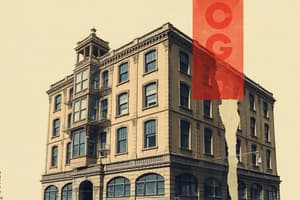Podcast
Questions and Answers
What is the definition of a theory?
What is the definition of a theory?
- A set of rules for planning and designing urban spaces
- A system of assumption or principles used in practicing a profession
- Abstract thought or speculation resulting in a system of assumption or principles used in analyzing, explaining, or predicting phenomena (correct)
- A framework for designing and constructing buildings
What is the name of the building shown in the picture?
What is the name of the building shown in the picture?
- Le Corbusier's House
- Villa Savoye (correct)
- The Architecture Building
- The Theory Building
What is the term for the three-dimensional integration of program elements and spaces?
What is the term for the three-dimensional integration of program elements and spaces?
- Enclosure System
- Spatial System (correct)
- Structural System
- Circulation System
Which direction does the orientation of AMIHAN face?
Which direction does the orientation of AMIHAN face?
What shape is often associated with stability?
What shape is often associated with stability?
What is the term for the grid of columns that supports horizontal beams and slabs?
What is the term for the grid of columns that supports horizontal beams and slabs?
What is the result of a form's specific configuration of surfaces and edges?
What is the result of a form's specific configuration of surfaces and edges?
What is the term for the hue, intensity, and total value of a form's surface?
What is the term for the hue, intensity, and total value of a form's surface?
What is the term for a form's location relative to its environment or visual field?
What is the term for a form's location relative to its environment or visual field?
What is the term for the surface characteristic of a form that affects both tactile and light-reflective qualities?
What is the term for the surface characteristic of a form that affects both tactile and light-reflective qualities?
What is the term for the variety in the use of gradations from black to white?
What is the term for the variety in the use of gradations from black to white?
What is the term for colors that tend to produce rage or passion?
What is the term for colors that tend to produce rage or passion?
What is the term for the meeting of two planes?
What is the term for the meeting of two planes?
What is the term for the desire for prestige, pride, and ambition?
What is the term for the desire for prestige, pride, and ambition?
Flashcards are hidden until you start studying
Study Notes
Architecture and Design
- A theory is a system of assumptions or principles used to analyze, explain, or predict phenomena, and is proposed or followed as a basis of action.
- Architecture is the art, science, or profession of planning, designing, and constructing buildings, considering their environment, utility, strength, and beauty.
Building Identification
- Villa Savoye is a building designed by Le Corbusier.
- Einstein Tower is a building identified by a specific image.
Architectural Systems
- A structural system consists of a grid of columns supporting horizontal beams and slabs, with a cantilever acknowledging the direction of approach.
- A circulation system involves the stair and ramp penetrating and linking three levels, heightening the viewer's perception of forms in space and light.
- A spatial system integrates program elements and spaces, accommodating multiple functions and relationships.
- An enclosure system defines a rectangular volume containing program elements and spaces.
Design Elements
- Volume has three dimensions: length, width, and depth.
- Orientation of Amihan is north-east, while Habagat is south-west.
- The triangle shape signifies stability.
Design Principles
- Dimensional transformation involves altering one or more dimensions of a form while retaining its family identity.
- Spatial tension is a design concept demonstrated by a specific image.
- Edge to edge contact is a design concept demonstrated by a specific image.
- Interlocking volumes is a design concept demonstrated by a specific image.
Safety Color Guides
- Red signifies "STOP".
- Green signifies "SAFETY".
- Blue signifies "MANDATORY ACTION".
- Orange signifies "DANGER".
- Yellow signifies "CAUTION".
Human Motivations
- Recognition arises from desire for prestige, pride, and ambition, social status, physical supremacy, and intellectual attainment.
- Self-expression is the urge to assert oneself as an individual and do things in one's own particular way.
- Response arises from the gregarious nature of man, from the wish for love, friendship, and sociability.
Form Elements
- Shape is the principal identifying characteristic of form, resulting from the specific configuration of a form's surfaces and edges.
- Color is the hue, intensity, and total value of a form's surface.
- Position is a form's location relative to its environment or visual field.
- Texture is the surface characteristic of a form, affecting both tactile and light-reflective qualities.
Form Composition
- Centralized forms are demonstrated by a specific diagram.
- Radial forms are demonstrated by a specific diagram.
- Corners define the meeting of two planes.
Color Theory
- Tone is a variety in the use of gradations from black to white, referring to the lightness or darkness of an object.
- Warm colors are advancing colors.
- Cool colors are receding colors.
- Red tends to produce rage or passion, is exciting, and stimulates the brain.
- Cool colors are sedative and soothing.
Studying That Suits You
Use AI to generate personalized quizzes and flashcards to suit your learning preferences.




